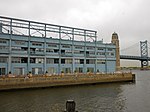Philadelphia Election riot
The Philadelphia Election Riot in 1742 was a riot that occurred due to political disagreements among the constituents of the increasingly diverse population in the city. Politics in Pennsylvania, including Philadelphia, had long been dominated by the Quakers but, with their political dominance increasingly threatened by the predominantly Anglican Proprietary Party, tensions grew in the city. The Quakers and Anglicans were predominantly led by Isaac Norris II and William Allen, both of whom were well respected and held significant political power. In an attempt to swing the vote, the Proprietary Party "hired armed sailors" to disrupt the Quakers who, in their own attempt, were bringing "unnaturalized Germans from the country to vote." On voting day, October 1, 1742, violence broke out between the two sides.
Excerpt from the Wikipedia article Philadelphia Election riot (License: CC BY-SA 3.0, Authors).Philadelphia Election riot
North 2nd Street, Philadelphia Center City
Geographical coordinates (GPS) Address Nearby Places Show on map
Geographical coordinates (GPS)
| Latitude | Longitude |
|---|---|
| N 39.95 ° | E -75.1437 ° |
Address
North 2nd Street 3
19106 Philadelphia, Center City
Pennsylvania, United States
Open on Google Maps










